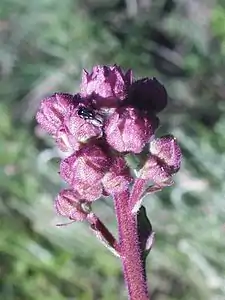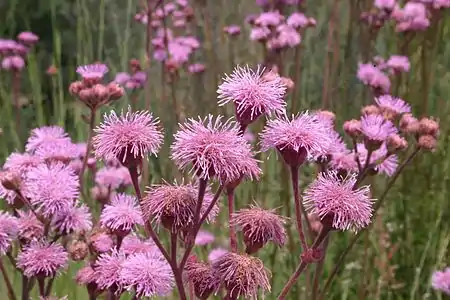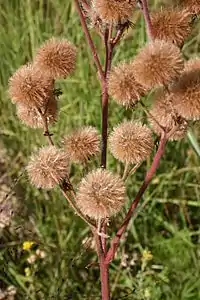| Eupatorium macrocephalum | |
|---|---|
 | |
| Scientific classification | |
| Kingdom: | Plantae |
| Clade: | Tracheophytes |
| Clade: | Angiosperms |
| Clade: | Eudicots |
| Clade: | Asterids |
| Order: | Asterales |
| Family: | Asteraceae |
| Genus: | Eupatorium |
| Species: | E. macrocephalum |
| Binomial name | |
| Eupatorium macrocephalum | |
Eupatorium macrocephalum Less. aka pompom weed, is a cosmopolitan perennial plant belonging to the family of Asteraceae and regarded as an invasive weed in some countries. It is native to the southern United States, Central America, South America and was introduced to South Africa.[1] It is classed as a principal weed in Brazil. In South Africa it has been cultivated as an ornamental, is often found on roadsides, and has become of concern for its invading of undisturbed climax grassland and wetlands since the 1960s.[1] It is closely related to Siam weed, and is one of some 268 species in the genus.[2]
This species is rhizomatous with erect stems to 1.3 m tall, and has stem and leaves covered in rough, bristly hairs. It forms dense rosettes of leaves at ground level, suppressing the germination and growth of other species, at the same time producing allelochemicals which adversely affect the growth of neighbouring plants.[3] The plant dies back annually to its root crown, and survives veldfires over the winter period. Its leaves are light green in colour, lanceolate-elliptic in shape, and measure 8 cm x 2 cm. Leaf margins are serrate, the teeth becoming smaller away from the stalk. Flower heads are surrounded by lanceolate, purplish bracts some 8 mm in length. Flowers are large, pink and showy, and exceed the bracts by 6–8 mm. Mature achenes are black and 5 mm long with a pappus of simple bristles.[4][5]
Moths of the genus Adaina and in particular Adaina microdactyla (Hübner), have been investigated as possible biological control agents. Species in the genus include flower borers, leaf feeders and also species that induce stem galls which provide food and accommodation for larvae and pupae.[6] Research at Cedara College of Agriculture has found a rust fungus, Puccinia eupatorii, which invades the seeds and kills the whole plant, including the roots. This rust fungus is specific to E. macrocephalum and would therefore be ideal as a biological control.[7][8] Other potential insect agents include a stem-galling thrips, Liothrips sp., and the moth Cochylis campuloclinium.[9]
Material from this species has been analysed, resulting in the identification of six triterpenes, one diterpene glycoside ester, six steroids, one flavonoid known as cirsilol, and six cinnamic acids derivatives.[10]
The name Eupatorium macrocephalum was first published in January 1830 by Christian Friedrich Lessing in Linnaea 5(1): 136–137. 1830.[11] "Eupatorium" was first used by Linnaeus to honour 'Eupator Dionysius' aka Mithridates, an ancient ruler of Anatolia, while 'macrocephalum' means 'large-headed' and refers to the inflorescence.
Synonyms
- Campuloclinium macrocephalum var. strigosum DC.
- Chromolaena pratensis Gardner
- Eupatorium albertinae Ant.Molina
- Eupatorium denudatum Chodat
- Eupatorium donianum Hook. & Arn.
- Eupatorium macrocephalum var. angustifolium Baker
- Eupatorium macrocephalum var. stigmatosum (Chodat) Hassl.
- Eupatorium macrocephalum var. strigosum (DC.) Baker
- Eupatorium stigmatosum Chodat [Illegitimate]
- Eupatorium stigmatosum var. subcalvatum Chodat
- Eupatorium stigmatosum var. violaceum Chodat
 Flower buds
Flower buds Flower heads
Flower heads Mature fruiting heads
Mature fruiting heads Cypselae or achene-like fruits/seeds
Cypselae or achene-like fruits/seeds
References
- 1 2 "Pompom weed: Origin and Distribution". ARC-Plant Protection Research Institute. 2013. Retrieved 1 May 2014.
- ↑ "Search results — The Plant List". Theplantlist.org. Retrieved 1 April 2022.
- ↑ "Archived copy" (PDF). Archived from the original (PDF) on 2014-01-09. Retrieved 2014-01-09.
{{cite web}}: CS1 maint: archived copy as title (link) - ↑ "Eupatorium macrocephalum" (PDF). Wssa.net. Retrieved 2022-04-01.
- ↑ "Campuloclinium macrocephalum | SANBI". Archived from the original on 2013-11-05. Retrieved 2014-01-09.
- ↑ Deborah L. Matthews; Boudanath V. Maharajh (2009). "ADAINA PRIMULACEA MEYRICK, 1929: A GALL-INDUCING PLUME MOTH OF SIAM WEED FROM SOUTH FLORIDA AND THE NEOTROPICS (LEPIDOPTERA: PTEROPHORIDAE)" (PDF). Trop. Lepid. Res. 19 (2): 64–70. Retrieved 2022-04-01.
- ↑ "Archived copy" (PDF). Archived from the original (PDF) on 2014-01-09. Retrieved 2014-01-09.
{{cite web}}: CS1 maint: archived copy as title (link) - ↑ "Pompom weed threatens SA's grasslands". Arc.agric.za. 28 June 2013.
- ↑ "Management and Control". Archived from the original on 2014-01-09. Retrieved 2014-01-09.
- ↑ Vega, MR; de Carvalho, MG; Vieira, IJ; Braz-Filho, R (2008). "Chemical constituents from the Paraguayan medicinal plant, Eupatorium macrocephalum Less". J Nat Med. 62 (1): 122–3. doi:10.1007/s11418-007-0168-1. PMID 18404357. S2CID 12541547.
- ↑ "Tropicos". Tropicos.org. Retrieved 1 April 2022.